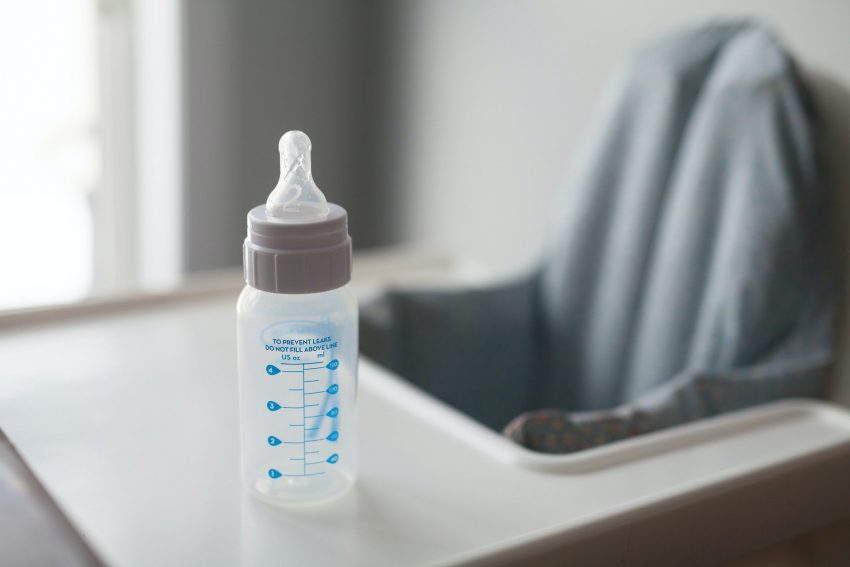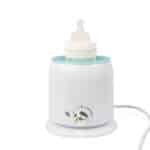When you have a formula-fed baby, you have to go through the process of searching the right bottle for them, and then finding the perfect nipple. On your journey, you’ll come across nipples with different flows. Some manufacturers guide you through this by giving you ages compatible for each nipple flow.
For example, a slow flow nipple is for newborn babies up to three months. A medium flow nipple is then for babies that are three to six months. Fast flow nipples are designed for babies that are older than six months.
This seems simple enough, but you can’t always go by the ages. Babies simply don’t come with a handbook. Some babies, like premature ones, might need to stay on a slow flow nipple longer than three months. Other babies might need medium flow nipples at two months. This leaves everyone asking when to change the nipple flow.
When To Change Nipple Flow: Signs They’re Ready
View in gallery
Instead of following a pre-determined age range that manufacturers came up with, take cues from your baby to determine when to change nipple flow. Pay attention to how they act when they eat and how quickly they finish a bottle while watching for these signs:
- Irritability. When your baby needs a faster nipple, they will get annoyed trying to drink from a slower nipple. You’ll notice that even though they are hungry they are pushing the bottle away, kicking, screaming, and just plain irritable during feeding time. This is because they want the formula faster and can’t seem to get it, which is frustrating.
- Longer feeding times. When your baby has a nipple that is the appropriate size, they’ll suck down a bottle in a solid half-hour or so, depending on how much they’re eating. It should take about five minutes for each ounce, give or take a few. If it’s taking your little one an hour to drink four ounces, they might be ready for a faster nipple.
- Snacking instead of eating. When it’s time to upgrade nipples, it will seem like your baby is snacking instead of eating. They will eat a little bit, then stop. Then, they’ll eat a little bit more. This will become their style of eating instead of drinking a whole bottle at a time. It’s because eating has become frustrating for them, so they won’t eat an entire bottle at a time.
- They suck really hard. When the bottle is not releasing formula fast enough, your baby will try to make it by sucking harder than usual. This is another reason they will not eat a lot at a time. It takes more effort to suck that hard on a bottle.
If your baby is frustrated during eating, shows other signs, and is not doing fine with the nipple that they have, it might be time to switch.
When To Change Nipple Flow: Signs It’s Too Early
If your baby isn’t experiencing any of the signs above, there is no need to change the nipple flow unless you want to. However, if you change it too early, your little one might choke because the formula comes out too fast.
They can also get gas from gulping down the formula as they try to keep up with the faster flow. The gulping motion means that they will swallow more air.
View in gallery
When To Change Nipple Flow: How To Transition
If you do choose to switch to a faster nipple before your baby is displaying a majority of the symptoms mentioned above, such as if they’re only taking a long time to eat, it’s important to transition properly.
Start With One Feeding
Begin with one feeding at a time. On the first day, feed them once with the faster flow nipple and watch for possible problems. For example, make sure that your baby doesn’t choke. See if they are gulping down their bottle and make a mental note if they develop gas.
Work Your Way Up
After the first feeding, slowly increase the number of times that you use a faster nipple until your little one has completely transitioned from a slow nipple to the next one. You can do this over one week or take several weeks if you prefer. It’s completely up to you and your baby.
We recommend Comotomo baby bottles. They are great for avoiding nipple confusion and have really good nipple flow:
[amalinkspro type=”showcase” asin=”B009QXDE32″ apilink=”https://www.amazon.com/dp/B009QXDE32?tag=mominformedcom-20&linkCode=osi&th=1&psc=1″ new-window=”true” addtocart=”false” nofollow=”true” sc-id=”4″ imgs=”LargeImage” link-imgs=”false” specs=”Comotomo baby bottles are deisgned to most closely mimic breastfeeding to reduce bottle rejection and nipple confusion issues~~~Ultra wide-neck design allows easy cleaning by hand without a brush. Nipple and body is made of 100% safe hygienic silicone~~~Safe in microwave, boiling water, dishwashers and sterilizers~~~Maximum temperature for bottle and nipple is 180 degree Celsius and 120 degree Celsius for cap and outer ring~~~” btn-color=”#ff9900″ btn-text=”Buy on Amazon” alignment=”aligncenter” hide-prime=”0″ hide-image=”0″ hide-reviews=”0″ hide-price=”0″ hide-button=”0″ width=”750″]Comotomo Baby Bottle, Green, 8 Ounce (2 Count)[/amalinkspro]
Give Breaks
It might take your baby time to adjust, and that’s okay. If your little one is not okay with a slower nipple but also not okay with a faster flow yet, give them the faster one as long as it’s safe.
Sit your baby up when feeding to prevent choking and make sure that you give your baby breaks. Feed for a few minutes, and then take the bottle out of their mouth for a couple of seconds. This gives them the chance to adjust to the faster flow without being overwhelmed, which can make them feel stressed.
If babies feel stressed while eating regularly, they can develop a negative association with eating.
You Don’t Have To Switch Nipples
View in gallery
Most parents, especially first-timers, read the age on the package of new nipples and instantly think that their baby will need a new one as they get older. Most babies will get frustrated with a slower nipple, but that does not apply to all babies. Some will simply eat slower. Others might never show a sign that they need a faster nipple.
If your baby is in the last category, don’t cave in to the pressure to upgrade nipples because of what the packaging says. As long as your baby is comfortable with the flow of the nipple, you’re doing a great job and there is no need to change anything.
Remember the adage: If it ain’t broke, don’t fix it. This also applies when switching nipples on the baby bottle.
Switching nipples on your baby needs careful consideration. Too early and they can choke. If they’re ready for a new flow, they can be angry and hungry most of the day. Follow these tips to make sure that you get it just right.






